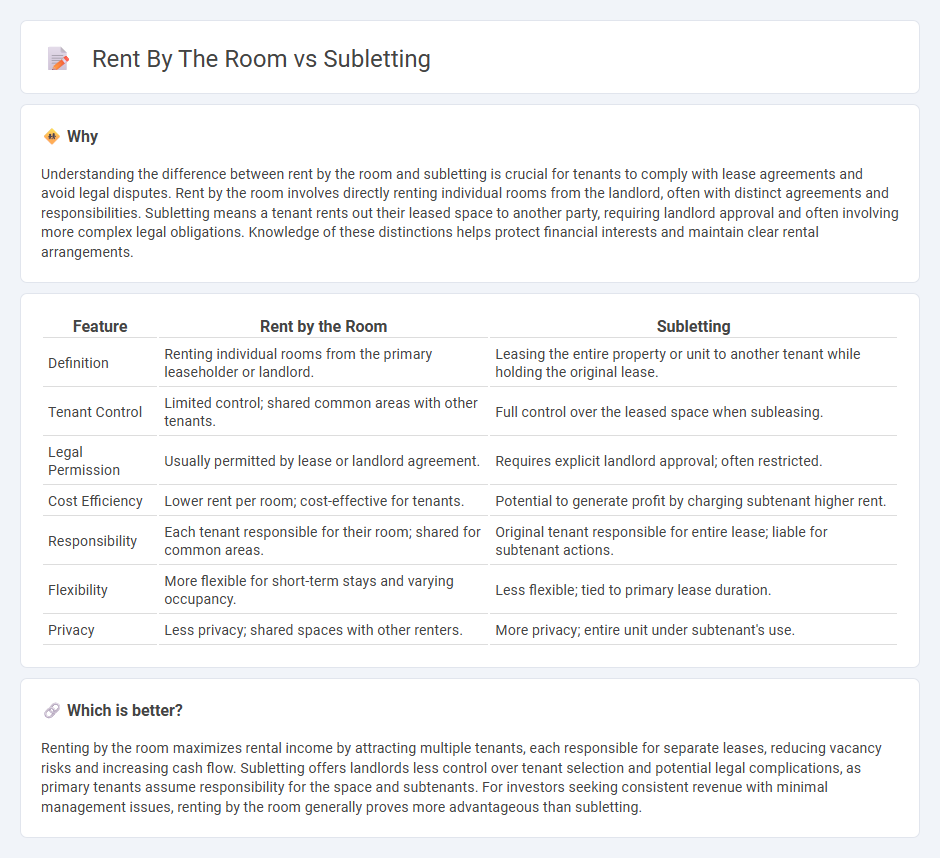
Rent by the room allows tenants to lease individual bedrooms within a property, often with shared common areas, providing affordable options and flexible living arrangements. Subletting involves a tenant leasing out their rented space to another party, usually requiring landlord approval and adherence to lease terms. Discover the key differences, benefits, and legal considerations to choose the best option for your housing needs.
Why it is important
Understanding the difference between rent by the room and subletting is crucial for tenants to comply with lease agreements and avoid legal disputes. Rent by the room involves directly renting individual rooms from the landlord, often with distinct agreements and responsibilities. Subletting means a tenant rents out their leased space to another party, requiring landlord approval and often involving more complex legal obligations. Knowledge of these distinctions helps protect financial interests and maintain clear rental arrangements.
Comparison Table
| Feature | Rent by the Room | Subletting |
|---|---|---|
| Definition | Renting individual rooms from the primary leaseholder or landlord. | Leasing the entire property or unit to another tenant while holding the original lease. |
| Tenant Control | Limited control; shared common areas with other tenants. | Full control over the leased space when subleasing. |
| Legal Permission | Usually permitted by lease or landlord agreement. | Requires explicit landlord approval; often restricted. |
| Cost Efficiency | Lower rent per room; cost-effective for tenants. | Potential to generate profit by charging subtenant higher rent. |
| Responsibility | Each tenant responsible for their room; shared for common areas. | Original tenant responsible for entire lease; liable for subtenant actions. |
| Flexibility | More flexible for short-term stays and varying occupancy. | Less flexible; tied to primary lease duration. |
| Privacy | Less privacy; shared spaces with other renters. | More privacy; entire unit under subtenant's use. |
Which is better?
Renting by the room maximizes rental income by attracting multiple tenants, each responsible for separate leases, reducing vacancy risks and increasing cash flow. Subletting offers landlords less control over tenant selection and potential legal complications, as primary tenants assume responsibility for the space and subtenants. For investors seeking consistent revenue with minimal management issues, renting by the room generally proves more advantageous than subletting.
Connection
Rent by the room and subletting are interconnected practices in the real estate market that allow tenants to generate income from a single rental unit by leasing individual rooms separately or by subleasing the entire property or parts of it. This approach maximizes rental yield and flexibility for both landlords and tenants, especially in urban areas with high housing demand. Understanding local regulations governing rent by the room and subletting is essential to ensure compliance and avoid legal complications.
Key Terms
Lease Agreement
Subletting involves a tenant leasing their entire rented property to another party under the original lease terms, often requiring landlord approval, while rent by the room entails multiple tenants signing individual agreements for separate rooms within a property. Lease agreements for subletting typically maintain the original tenant's liability, whereas rent by the room agreements assign direct responsibilities to each tenant for their specific portion. Explore detailed differences in lease agreements to choose the best housing option for your needs.
Occupancy Rights
Subletting involves a tenant renting out their entire leased property or a portion of it to another party, whereas rent by the room specifically pertains to leasing individual rooms within a property to separate tenants, each typically having distinct occupancy rights. Occupancy rights in subletting often depend on the original lease agreement and may require landlord approval, while rent by the room arrangements grant tenants specific rights linked to their individual rooms, including access to common areas. Explore more to understand how these differences impact tenant protections and legal obligations.
Rent Payment Structure
Rent payment structures differ significantly between subletting and rent by the room. Subletting typically involves a single payment to the primary tenant, who then manages the overall rent, while rent by the room requires each tenant to pay rent separately to the landlord, often resulting in fixed individual lease agreements. Explore the detailed implications of these payment structures to choose the best housing arrangement for your needs.
Source and External Links
Subletting | Off-Campus Living & Community Initiatives - Subletting occurs when a current tenant rents their room or apartment to another person, with the original tenant remaining legally responsible for the lease, and typically requires written permission from the landlord.
What is Subletting and How Does it Work? - Neighbor Blog - Subletting means you, as the original tenant (sublessor), rent out part or all of your space to a new tenant (sublessee), while you remain on the primary lease and responsible for payment and maintenance.
All About Subletting - Tenant Resource Center - A sublet is a binding agreement where a new person is added to an existing lease, usually replacing someone moving out, and all lease rules and local laws continue to apply to all parties.
 dowidth.com
dowidth.com